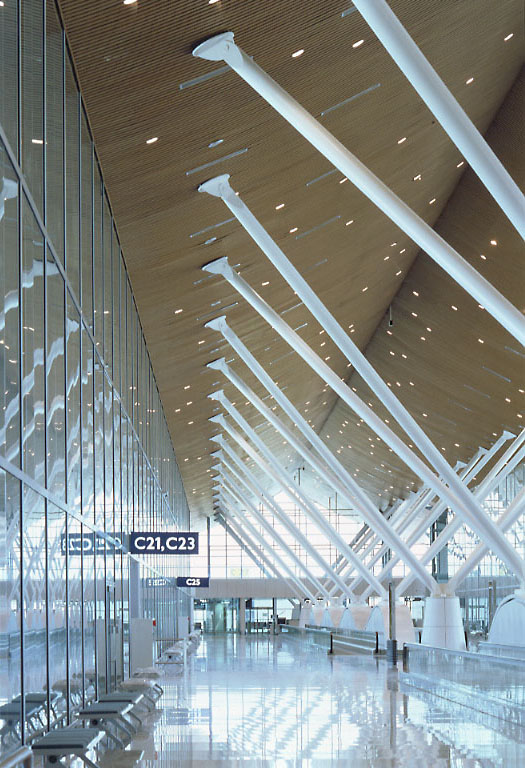K.L. International Airport (KLIA) at Sepang
is designed and built to be an efficient, competitive
and world-class hub airport for the Asia-Pacific
Region. It replaces the Sultan Abdul Aziz Shah
International Airport at Subang as the main
gateway into the nation. The new mega airport,
complete with the latest technology and state-of-the-art
facilities, aims at providing maximum passenger
safety, comfort and convenience. It is unique
because it has within its boundaries all that
is needed for business, entertainment and relaxation.
In short, KLIA is a destination in itself.

PLANNING
The planning and development of the new Kuala Lumpur International Airport at Sepang, Malaysia began in early 1990 when it became evident that the existing Sultan Abdul Aziz Shah International Airport (formerly Subang International Airport) has limited expansion capability to meet long term increase in passenger and cargo demand. The government, therefore, decided to build a new airport at an alternative site to accommodate not only the rapid increase in air transport, but also to meet the growing demand of the tourism and services sector.
The selection of the new airport site was made following site selection studies which required several primary criteria to be met. Requirements included:
- Sufficient land size for expansion
- Potential for access time from Kuala Lumpur within 30 minutes
- Strategic location near major towns in the Klang Valley
- Satisfaction of aeronautical requirements
- Suitability of infrastructure
- Minimal adverse impact on social and environmental issues
Land at the new airport site consisted of oil palm plantations, mixed agriculture and a small Orang Asli settlement of approximately 85 families. These families were located to new homes and were provided with their own plots of land to cultivate.
SUPERLATIVES AND FEATURES
The airport is built on 10,000 hectares (25,000 acres - one of the world's largest construction site) or 100 sq. km. of agriculture land once thick with rubber and palm oil plantations which makes it one of the largest airport sites in the world. KLIA was completed in four and a half years with round-the-clock construction work (making it the fastest airport ever built) undertaken by an international workforce of 25,000 people (largest number of workers for a Malaysian project) at a cost of about US$3.5bn and commenced full commercial operations on June 28, 1998. The large size of land designated for the airport would allow the airport to expand as needed to meet present and future air traffic demands.
With a rambling roof resembling white Bedouin tents, the five-level KLIA boasts the world's tallest air-traffic control tower, the biggest columnless hangar, the longest baggage conveyor belt system, biggest passenger lounge and the capacity for 25 million people a year. The airport has a Made in Malaysia, RM24 million Olympex flight information display system.
KLIA is the second airport in the world after Munich to have a special chamber to defuse explosives as part of its sophisticated fire-fighting systems. It has two decompression chambers costing RM 3.2 million to dispose of explosive materials. KLIA's fire fighting unit is the most modern in the region. It is the first in the region to secure seven Ultra Large Foam Tender (ULFT) vehicles costing RM 3.8 million each which can be operated in any condition.
 ARCHITECTURE
ARCHITECTURE In 1998 when the first passengers arrive at the new KLIA, at Sepang, they will experience glimpses of a green Malaysia through the unique architecture, enjoy the world renowned Malaysian hospitality and feel the ease of modern hi-tech conveniences that reduce waiting time.
Designed by renowned Japanese architect Kisho Kurokawa, the KLIA is a spectacular feat of construction which combines futuristic technology, Malaysian culture and the rich, tropical splendor of its natural resources, and is regarded as one of the most modern and sophisticated airports in the Asia-Pacific region. It will incorporate forms and systems suggesting advancement and modernization while at the same time, support Malaysia's cultural history.
AIRPORT IN THE FOREST
From the air, the KLIA looks like a futuristic structure hidden in a remote jungle. Encircling the airport is a tropical forest. More than a million trees and shrubs are transplanted both within and outside the large Passenger Terminal Complex, according to the airport management authorities.
Malaysia is home to the world's oldest tropical rain forests. The KLIA is therefore often described as the "airport in the forest, forest in the airport", so flexuous would be the boundaries between the physical structure of the airport and its green ambience.
Every effort has been made to create a homely airport with a serene environment combined with high technology attractions. Nature and greenery will be part of the airport in line with the airport in the forest and forest in the airport concept. The natural environs of the airport will be transformed to functions and activities that continue to enhance nature. The architecture of all the new facilities will maximise the use of the forest concept and imagery with strategic locations designed with high standards of environmental performance in mind.
The abundant forest areas are to be preserved and transformed into an environment park containing recreational facilities. There will also be a golf course within the limits of the airport reserve.
Malaysian Prime Minister Datuk Seri Doktor Mahathir Mohammad said: "KLIA is not just an airport. It is a piece of art, dedicated to beauty as well as the environment. It relates to the greenness and the forests of Malaysia, both inside and outside."